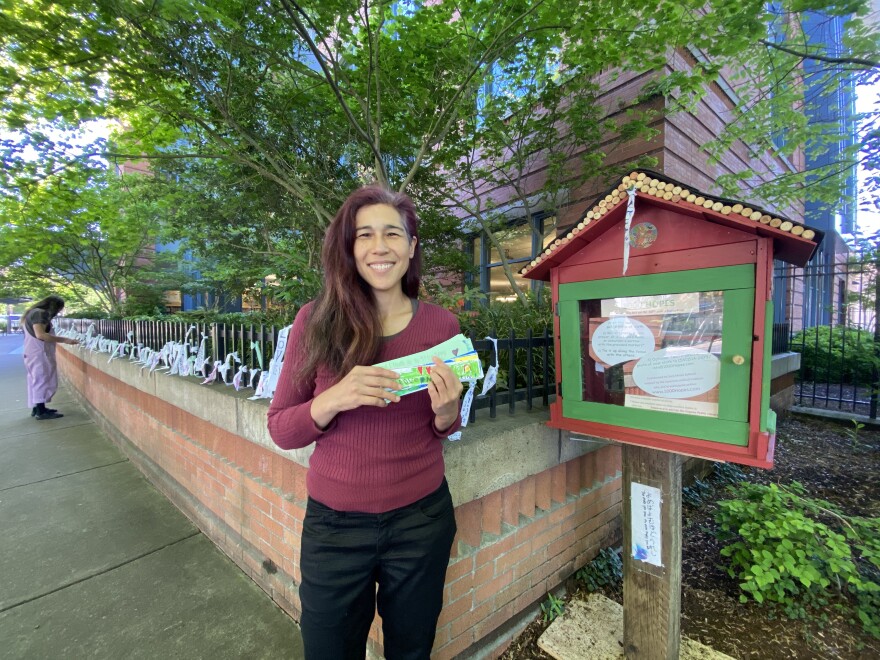For Asian American and Pacific Islander Heritage Month, the Eugene Public Library is hosting a collaborative art installation called one thousand hopes. Coordinator Sara Miura Zolbrod drew on her experiences as an Asian Jewish American to create the project.
“I remember tying a long white piece of paper onto a tree that had thousands of other pieces of paper on it.”
As a child, Zolbrod thought this was a wishing tree. After some research, she learned it is a tradition called Omikuji where people can pay for a range of fortunes. And all the fortunes tied together, get amplified.
This cherished memory at a Japanese temple brought inspiration for the 1,000 Hopes Community Art Installation.
“I’m not necessarily trying to be true to the tradition because I’ve changed some things,” Zolbroad said. “I ended up inviting the Eugene community to either share a hope, or a wish or a dream or a prayer. Or a sorrow.”

The shootings which killed six women of Asian heritage at two spas in Atlanta occurred while Zolbrod was generating the idea for this project.
“I thought of this idea before that happened,” Zolbrod said. “But after that happened, I realized that this could also take the form of a way to memorialize loved ones that we’ve lost or try to speak up against those sorrows or those oppressions.”
Zolbrod plans to add the names of the Atlanta Shooting Victims to the fence. She will also add Black citizens who have been killed by police. And Lane County residents taken to Japanese concentration camps during World War II.
Aimee Yogi, co-president of the Japanese American Association of Lane County, has researched how the Japanese Internment during World War II impacted Lane County residents.
In February 1942 President Roosevelt signed an Executive Order which led to the forcible removal of 120 thousand American citizens of Japanese ancestry. Twenty-three Japanese American students were attending the University of Oregon at the time.
“So, all residents of Japanese ancestry had to register at Civil Control Stations. That address now is right under the Hult Center,” said Yogi.
Of the 23 students, three were Lane County residents - Woodrow Ichihashi, Chiye Arai and Hitoshi Kin Wanatabe.
“Twenty students went. Joined their families,” Yogi said. “And our 3 students were assigned to concentration camps.”
Yogi was only able to find a record for Ichihashi, who was incarcerated at Tule Lake.
Being a part of the Western Defense Command area, colleges on the west coast joined together, creating the Japanese American Student Relocation Council, to help their Japanese American students continue their studies during the relocation and internment.
Yogi discovered that a University of Oregon employee, Karl Onthank, was part of this effort.
The goal was to find inland universities to take the students, without admissions barriers, and to help them relocate once they were admitted to another institution.
“The council continued to recruit students in the concentration camps,” said Yogi. “By September 1943, they had placed 5,500 students into 529 colleges and universities.”
The names of all 23 students forced to leave the University of Oregon can be found on the Eugene Japanese American Memorial at the Hult Center.
Aspects of this history are reflected in Zolbrod’s experience. Her mother was born in Japan and her father is Jewish American. Growing up she lived in both Canada and Japan.
“Probably with my upbringing… always been sensitive to the outsider experience. I was pointed out as being the outsider a couple times as a child,” Zolbrod said. “I think the gift of that was that I try to be an inclusive person.”
Zolbrod has invited students at six local elementary schools to participate. Over 1,000 papers written by the kids will be hung on the fence at the library.

“I hope this art installation is a welcoming activity,” said Zolbrod.
The installation is available 24 hours a day until the end of May. Community members can use supplies in the art hut located next to the fence to share their wishes, hopes, dreams and sorrows.
To follow up on this project, Zolbrod and Yogi will both participate in an online event hosted by the Eugene Public Library on June 5th.






